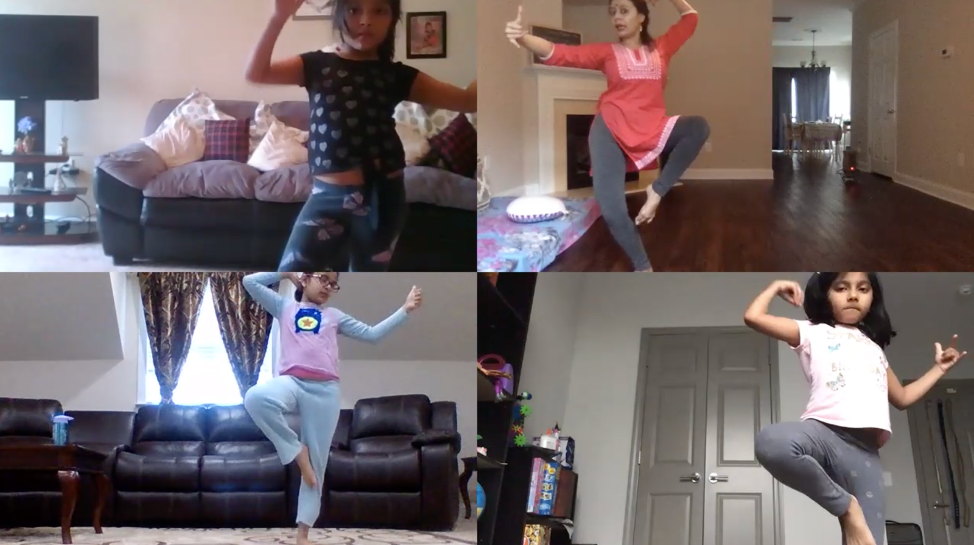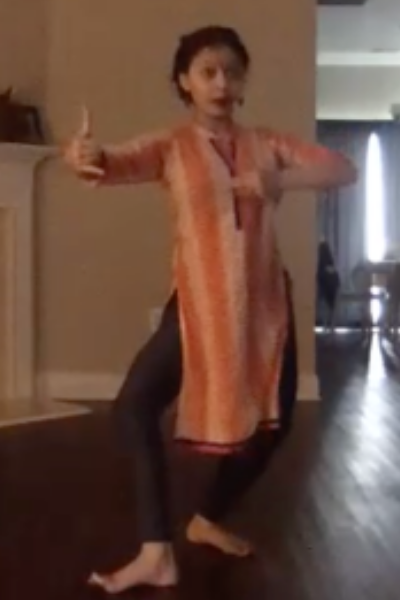From time to time, NDEO features guest blog posts, written by our members about their experiences in the fields of dance and dance education. We continue this series with a contribution by Kaustavi Sarkar, Professor, Department of Dance, University of North Carolina at Charlotte. Guest posts reflect the experiences, opinions, and viewpoints of the author and are printed here with their permission. NDEO does not endorse any business, product, or service mentioned in guest blog posts. If you are interested in learning more about the guest blogger program or submitting an article for consideration, please email Shannon Dooling-Cain at sdooling@ndeo.org
Sadhana: A Philosophy of Practice Across Analog and Digital Conduits
By Kaustavi Sarkar, Professor, Department of Dance, University of North Carolina at Charlotte
Daily dance practice or Sadhana is crucial in the life of an Indian classical dance practitioner. Movement of the physical body becomes second nature ingrained within muscle memory within this daily bodily regimen. The emotional nuance that remains central to engaging with the corporeal also needs substantial attention to detail on a daily basis. Training in movement requires practicing both Nritta, or rhythmic abstraction and Natya, or acting. Abhinaya, or movements including facial expressions elaborating literary, narrative, and emotional content, require nuanced tuning of the emotional and the experiential. For example, in the depiction of Shringar or the flavor of love by Guru Kelucharan Mohapatra in the poetic depiction of Jayadeva’s Gitagovinda (a medieval Indian text), one can imagine the feeling of sexual attraction, relate to lived experience, as well as imbibe instructions from one’s guru in order to conjure the emotion for the viewer. The dancer can participate in an energetic exchange of emotions and aesthetics with the viewers during a performance. However, during one’s Sadhana, when no audience is present, this exchange might happen with the mirrors in the studio or it is simply internalized within the dancing. In theory, Indian classical dance often relies on Sastric or scriptural origins where human emotions abstract the divine yearning of the body. Sadhana is the fertile ground where the dancer trains to work on such a magical chemistry, also known as Rasa. Rasa means flavor, taste, or emotional fervor. It has both aesthetic and spiritual significance. Virtuosity in the performance lies in the dancer’s acute ability to create Rasa. Such an emotional fervor results from within the precepts of geometric precision alongside expressional depth in repetitive practice of canonical repertoire and of choreographic innovation.

The culturally rooted practice of Sadhana also accounts for the creative potential of the practitioner, as artists around the world embed their traditional practice with variant manifestations across aesthetics, politics, social justice, and religiosity. Dance-scholar Nandini Sikand argues that dancers today engage with traditional movement idioms and thematic constructs “continuously and dynamically to create innovative work that is accomplished through sadhana/daily practice such that innovation becomes an embodiment of that effort” (234). In certain ways, innovation results from a spiritual seeking, as in the case of Ananya Dance Theatre (ADT), a Minnesota based contemporary Indian dance company rooted in deconstructed classical Indian dance. In its ensemble choreography, ADT creates metaphorical aesthetics of social justice issues of inequity connected to women of color, where the concept of spiritual seeking is stretched towards spiritual transformation. In creating people-powered-dances-of-transformation, ADT envisions an alternate futurity based on collectively breathing and sweating through Sadhana, as dancers train their bodies to sync emotions, corporeality, affective relationality, creative potential, and social justice activism.
During the ongoing COVID-19 pandemic, the screen becomes a crucial portal of engagement. Famed novelist Arundhati Roy shows how the coronavirus might be a “portal, a gateway between one world and the next,” and perhaps, a possibility for reimagining futures. As an Odissi soloist-scholar-educator (Odissi is an eastern Indian classical dance form), I innovatively deploy my Sadhana as a modality of building virtual communities of practice with students as well as peers using online networking platforms, such as ZOOM. New York Times dance critic Gia Kourlas notes that sensorial alertness of one’s spatial positioning determines life and death in the era of social distancing. She goes on to comment that “if this pandemic is teaching us anything, it is that we need to return to our bodies. Life is precious, and so is movement.” As a dance educator, I bring that sense of embodied urgency to provide voice, agency, and creativity to my students from among youth and adult populations. Odissi scholar Shreelina Ghosh cautions that “digital mediation and its grammars can unintentionally distort, disembody, and decontextualize the very cultural memories that it strives to protect and represent” (282). In my pedagogies of digital transmission, I attend to the distortions of movement via digital mediation, accounting for the lack of embodied exchange between the teacher and the student through hands on movement training using touch. I alternate my teaching of material between detailing of gestures, postures, and facial expressions with full-bodied movement in space and rhythm. I physically come closer to the screen to identify the Mudras (hand gestures), Padabhedas (foot positions), Bhavas (emotional states), and Bhangas (standing postures). I then show the absorption of detailing across gesture, posture, and limbic extremity alongside navigating space and time. The digital temporal lag makes it hard for teaching rhythm-based movement. Instead of chanting the bols (mnemonic syllables) myself, I use an online metronome that is easily available online. I also audio record my voice for students to practice during their homework assignments.

Alongside providing foundational elements, grammatical principles, and information about the canonical repertoire in solo performance, I encourage my students to connect to the ecological body. For example, I encourage my youth ranging from four to seven years of age, to find parallels between Mudras and the animal kingdom. Holding the Simhamukha that represents the face of a deer or a cow, I ask them to run around like the animals. While the younger folks come up with unstructured choreographic material that is more realistic, my teen students process the syntactical principles within the Odissi style and generate phrasing that is more in tune with the form. My adult students, learning either for professional pursuit of dance or for pleasure, connect their lived experiences of emotion, spirituality, agency, sense of justice, and empowerment with the movement. Reconceiving Indian classical dance pedagogy as a modality of sensorial alertness for creative deployment in the real world questions the traditional role of the female dance teacher of imparting tradition to her female students as noted by Indian classical dance pedagogue Sumana Sen Mandala.
In addition to pedagogical innovations of Sadhana, I find it potent in establishing peer communities of practice with other artists where we collaborate on choreographic deployment of breath, movement, and Rasa. Through Sadhana or my daily engagement with dance, I innovate strategies of connection and relationality repurposing solo traditional movement training through dance education and choreography converting my living to a laboratory of Rasananda, ecstatic joy in the experiential encounter of Rasa.
References
Cushman, Ellen, and Shreelina Ghosh. “The Mediation of Cultural Memory: Digital Preservation in the Cases of Classical Indian Dance and the Cherokee Stomp Dance.” Journal of Popular Culture, vol. 45, no. 2, 2012, pp. 264–283.
Korlous, Gia. “How we use our Bodies to Navigate a Pandemic.” The New York Times, 31 March 2020.
Roy, Arundhati. “The Pandemic is a Portal.” Financial Times, 3 April 2020.
Sen Sumana M. “Traditional Challenges, Challenging Tradition: Helping Students Find Agency in Bharata-Natyam at the Junction of Ancient Indian Thought, Somatic Practices & Feminist Pedagogy.” Journal of Dance Education, 2020, pp. 1-11.
Sikand, Nandini. “Beyond Tradition: The Practice of Sadhana in Odissi Dance.” Journal of Dance & Somatic Practices, vol. 4, no. 2, 2012, pp. 233–247.
 Kaustavi Sarkar, Assistant Professor in the Department of Dance at the University of North Carolina at Charlotte, is an Indian dance artist/ academic. She is the Artistic Director of Kaustavi Movement Center, an India-based organization dedicated to feminist, queer, and transnational research and dissemination of Indian classical dance. Her interdisciplinary research interests include digital humanities, cultural studies, practice-as-research, queer studies, and religious studies. She has presented her scholarly/ creative research at World Dance Alliance, Dance Studies Association, South Asian Studies Conference, Triangle Digital Humanities Institute, and Game Developers Conference. Her work has been published by Choreographic Practices, Performance Research, Research in Dance Education, Kairos: A Journal of Rhetoric, Technology, and Pedagogy, and Dance Research Journal. She is working on her monograph Dance, Technology, Social Justice currently under review with McFarland Publishers. She holds an MS in Economics from Texas A&M University and a PhD in Dance from The Ohio State University.
Kaustavi Sarkar, Assistant Professor in the Department of Dance at the University of North Carolina at Charlotte, is an Indian dance artist/ academic. She is the Artistic Director of Kaustavi Movement Center, an India-based organization dedicated to feminist, queer, and transnational research and dissemination of Indian classical dance. Her interdisciplinary research interests include digital humanities, cultural studies, practice-as-research, queer studies, and religious studies. She has presented her scholarly/ creative research at World Dance Alliance, Dance Studies Association, South Asian Studies Conference, Triangle Digital Humanities Institute, and Game Developers Conference. Her work has been published by Choreographic Practices, Performance Research, Research in Dance Education, Kairos: A Journal of Rhetoric, Technology, and Pedagogy, and Dance Research Journal. She is working on her monograph Dance, Technology, Social Justice currently under review with McFarland Publishers. She holds an MS in Economics from Texas A&M University and a PhD in Dance from The Ohio State University.